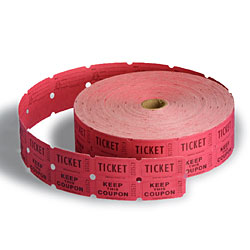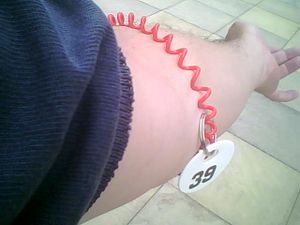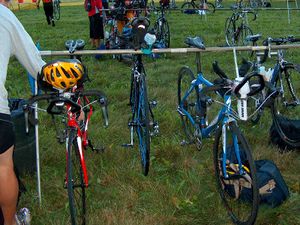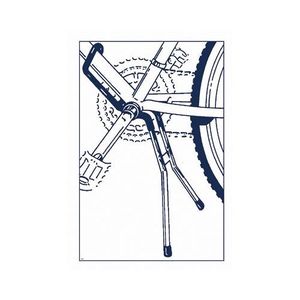Valet Bike Parking: Difference between revisions
m (→Cons) |
|||
| Line 44: | Line 44: | ||
== Keeping track of bikes: Coat-check system == | == Keeping track of bikes: Coat-check system == | ||
[[Image:Wristband_tag.jpg|thumb|Wrist Band with Coat Tag]] | |||
'''Coat-check system''' is a more polished version than raffle tickets, but also more expensive. | '''Coat-check system''' is a more polished version than raffle tickets, but also more expensive. | ||
Revision as of 19:40, 21 July 2008
Valet Bike Parking is a great service to the community and advertising tool for community bike shops and advocacy organizations.
What is it?
Simply put, when attending an event instead of leaving your bike chaining up a post, you leave it with someone who is going to keep an eye on it. This not only ensures the safety of their bike, but it creates a centralized gathering point (aka social spot) for all the cyclists attending the event -- this encourages people to ride. The event itself benefits because to the decreased demand for car parking and the organization running the valet bike parking has great exposure to the local cycling population.
Liability
Chances are the people that would take the time to sue over a small scratch are not apt to use your service in the first place. Regardless, you should have insurance, and if the event has really high end bikes showing up, a waiver form never hurts.
Setting Up
Again, this is an opportunity to advertise what you do so make it look professional, safe, and informative.
Rope it off
With enough volunteers watching the bikes you don't really need a border. HOWEVER, it gives people piece of mind to see that their bike is in a protected area with borders. Use caution tape, or to be more environmentally friendly use a re-usable brightly colored nylon rope.
Keeping track of bikes: Raffle Tickets
Raffle tickets are a cheap and easy way to do it. Buy a roll of 2,000 from Office Depot for under $8. For larger events buy different colors of raffle tickets where each section has its own color -- this makes bike retrieval much easier.
Instructions
- Tear off a pair of tickets.
- Give one raffle ticket to the bike owner (usually the one that says "Keep this Ticket").
- Wedge the other one in between the spokes. If they have radial spokes, aerowheels, or spokes that don't touch (high end wheels and old schwinns) just tape it to the frame or wedge them somewhere else like a brake hood.
- When they come back to retrieve their bike make sure the numbers match.
Pros
- Inexpensive
- Compact, less to carry.
- Requires little to no effort for volunteers to keep a count. If you keep track of the number on the first ticket, and subtract it from the number on the last ticket, you have a count of how many bikes you parked for the day!
Cons
- People lose can raffle tickets because they are small.
- Numbers are small and can be hard to see in the dark.
- Not as professional looking.
- Raffle tickets are not reusable.
Keeping track of bikes: Coat-check system
Coat-check system is a more polished version than raffle tickets, but also more expensive.
Order coat check numbers on the Internet: these are paired numbers printed on plastic disks with a hole in the top for placing on a coat hanger. Also get some plastic wrist coils from IDWholesaler. Put a number on each wrist coil, and use some sort of loop (we started with elastics) on the corresponding number. Attach the matching numbers together.
Instructions: Used / Unused Method
- Take a pair of numbers out of the "unused" bin or rack (by having a unused and used bin, we know at the end of the day how many bikes we parked).
- Give the wrist coil to the cyclist.
- Attach the matching number to the bike: with a loop or elastic you can clove hitch it to the handlebar.
- When they come back, verify the numbers match and give them their bike.
- Attach the two numbers together and dump in the used bin.
- When you've finished parking bikes, count either the used or unused bins to see how many bikes you parked. This may seem tedious, but it is important information for seeking funding or selling this service to other organizations.
NOTE: You must have more tags than you will need, if you have to reuse tags, it becomes hard to keep track of and will throw off the final count.
Instructions: Sequential Method
- Keep the numbers in numerical order on a pole (a bicycle rim suits this purpose very well, and is an excellent way to recycle with a bicycle theme).
- Pass out the numbers in numerical order.
- As you have people return, put their numbers into a used bin.
- When you've finished, the last number on the pole or rim is the number of bikes you parked plus one.
Pros
- Professional looking.
- Tags are harder to lose -- since they are strapped to their wrist.
- Easier to see and match larger numbers, especially in the dark.
- Tags are reusable, eliminating waste.
Cons
- Expensive
- Bulkier, more to carry.
- No replacements for single numbers, lost numbers can throw off counts permanently so they need to be accounted for.
- Counts are more labor intensive.
Storing the Bikes
- Build a tall saw horse out of either metal or wood and hang the bikes by their seats.
- Cycle-Safe has a professional version of a saw horse called the Bike-Check™ Portable Bicycle Parking System.
- Use Bottom Bracket Type Display Stands. NOTE: These will not work with over-sized down tubes. Also, these should not be used with fixed gears, as it lifts the rear wheel off the ground, creating a hazard for children who like spinning wheels, and could catch their fingers in the drivetrain.
- Use kickstands. If you are parking bikes on grass, you might want to grab some small blocks of wood or crushed aluminum cans to put under the kickstands so the bikes don't fall over.
- Flip the bikes upside down or on their side. DO NOT FLIP OVER THE FOLLOWING:
- Bikes with lights on handlebars
- Bikes with computers on handlebars
- Bikes where all the weight would be on the shifters.
- Older road bikes where brake housing comes out of the top of the brake hood may damage the cable.
- Children who grow with bikes in the house have a natural propensity to spin wheels. Since fixed gears create a hazard when the wheel is spun, it is not recommended that you flip these upside down either.
Valet Bike Parking Services
Recycle-A-Bike
They have done this for bike auctions and other fundraisers and public events.
Salt Lake City Bicycle Collective
Does this for downtown Salt Lake City events such as the Farmers' Market.
Chicago Bicycle Federation
They work with banks to pay for Valet Parking at many down town events through the summer, night time movie nights, food, cultural events, triathlons, and the end of family bike ride.
Simple snow fencing, for the outside barrier, three staff, metal racks for 500 bikes, and paper claim tickets for the patrons and their bikes, a repair stand if you want to get fancy.
San Francisco Bicycle Coalition
They do this all the time at major events.
Urban Bike Project of Wilmington
We have and will continue to do so. Big race in Wilmington last year, we parked about 200 bikes...It was a bit of a mess (most of these bikes parked in a half hour immediately following a bike parade) but our first time and plenty to be learned from the experience.
Ohio City Bicycle Co-op
This is one of our most effective outreach avenues. We charge event organizers for the service, and provide as much extra service to users as time allows: safety checks, oil and air, helmet fit, where to ride, etc. Our outline of this service is here:[1]



